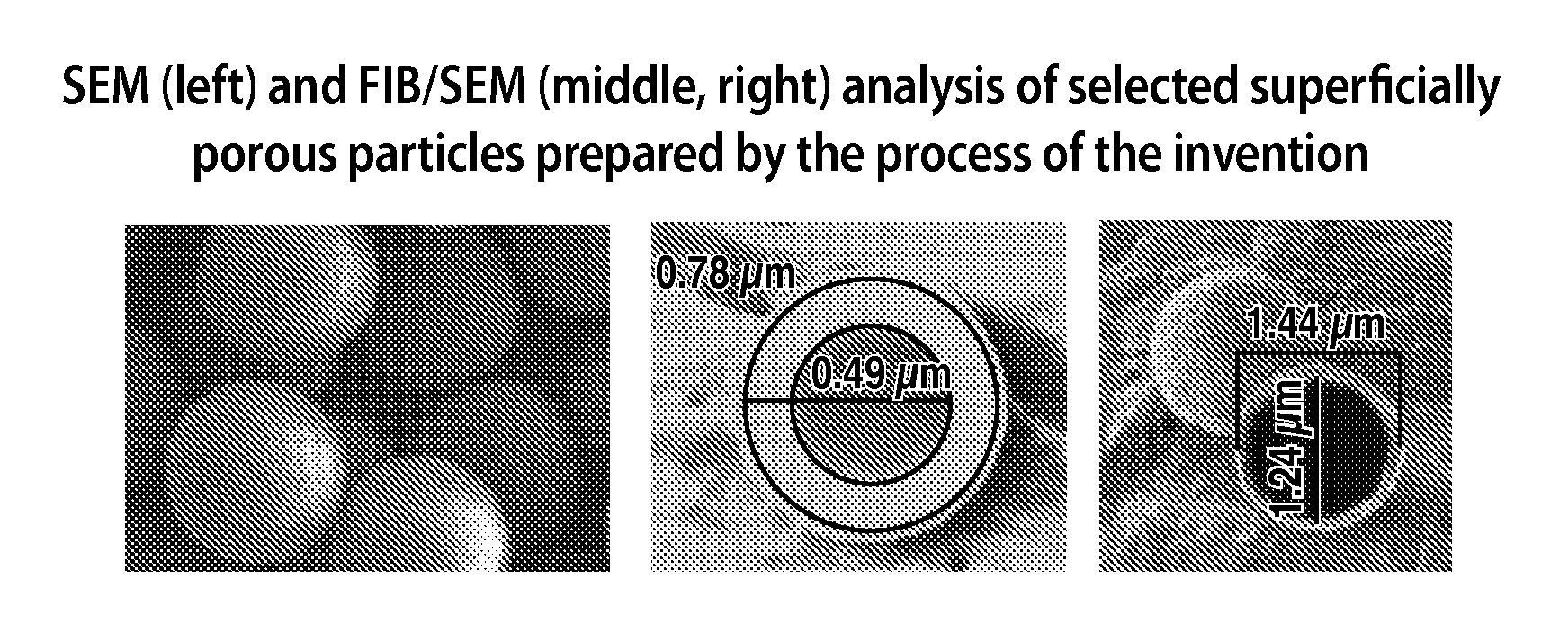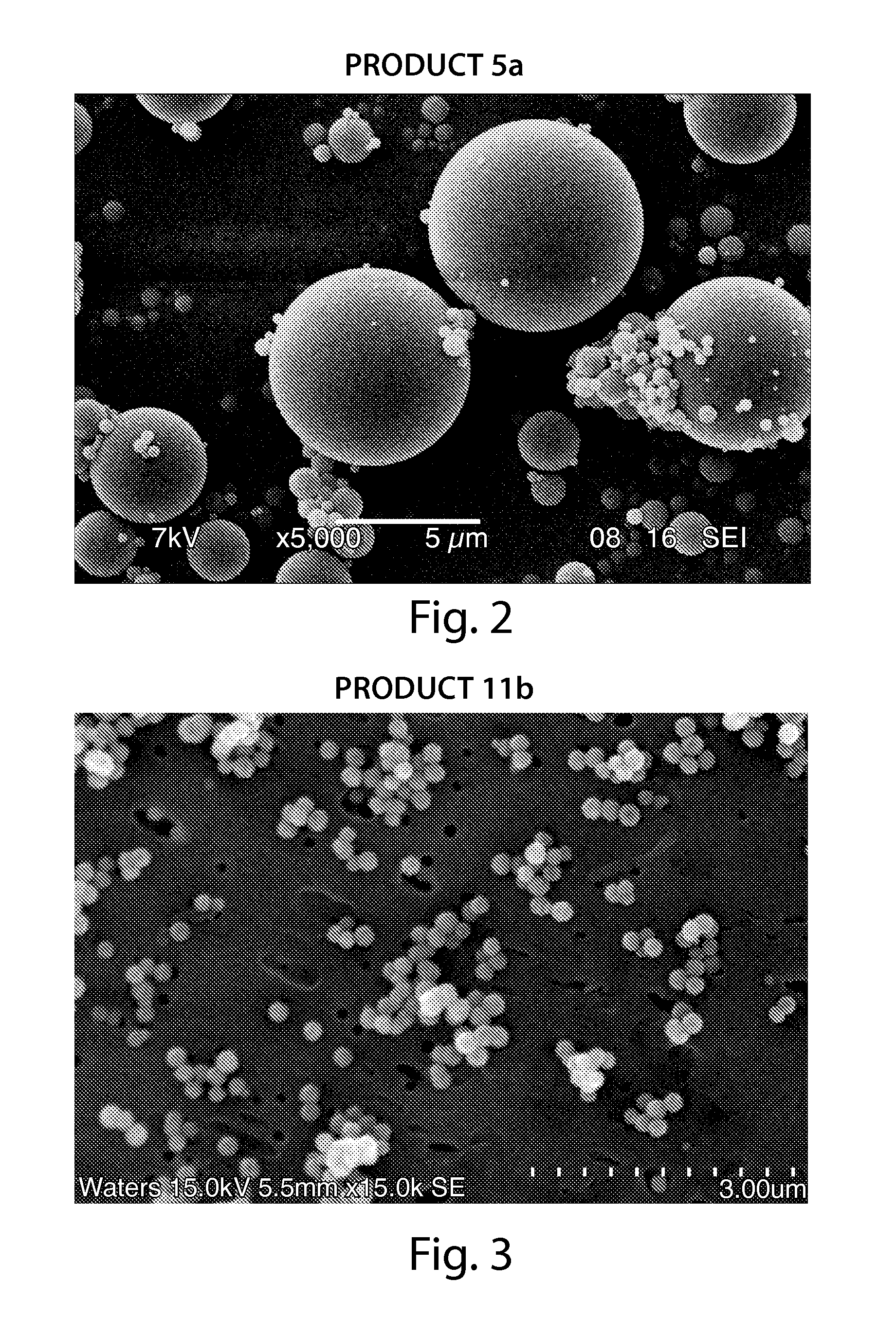Superficially porous materials comprising a substantially nonporous core having narrow particle size distribution; process for the preparation thereof; and use thereof for chromatographic separations
a technology of substantially nonporous core and particle size distribution, which is applied in the field of superficially porous materials comprising a substantially nonporous core having narrow particle size distribution, and the process for the preparation thereof, can solve the problems of low yield of narrow distribution, insufficient particle size (1-2 m) for effective use, and insufficient chromatographic enhancement of pore geometry. to achieve the effect of preventing fine generation, aggregation and agglomeration
- Summary
- Abstract
- Description
- Claims
- Application Information
AI Technical Summary
Benefits of technology
Problems solved by technology
Method used
Image
Examples
example 1
[0518]Nonporous hybrid particles were formed following a modification of a reported process {Choi, J. Y.; Kim, C. H.; Kim, D. K. J. Am. Ceram. Soc., 1998, 81, 1184-1188. Seog, I. S; Kim, C. H. J. Mat. Sci., 1993, 28, 3277-3282}. To a clean 40 mL vial was added a stir bar, water (26 mL) and 14.8 M NH4OH (4.3 mL). This solution was then heated to 60° C. with stirring (600 rpm) in a water bath before one or more alkoxysilanes, including phenyltriethoxysilane (PTES, Gelest, Morrisville, Pa.), 1,8-bis(triethoxysilyl)octane (BTEO, Gelest, Morrisville, Pa.), 1,2-bis(triethoxysilyl)ethane (BTEE, Gelest, Morrisville, Pa.), 1,2-bis(methyldiethoxysilyl)ethane (BMDEE, Gelest, Morrisville, Pa.), vinyltriethoxysilane (VTES, Gelest, Morrisville, Pa.), or mercaptopropyltrimethoxysilane (MPTMS, Lancaster Chemical, Lancaster UK) were added (3 mL total). The reaction was sealed, and returned to the 60° C. water bath for 2 h. The reaction was further continued for 24 h at 25° C. The particles were isol...
example 2
[0519]Nonporous hybrid particles were formed following a modification of a reported process {U.S. Pat. Nos. 4,983,369 and 4,911,903}. To a clean Nalgene bottle (125 mL) was added a stir bar, water (14 mL), ethanol (80 mL), and NH4OH (7 mL, 14.8 M). One or more alkoxysilanes, including tetraethoxysilane (TEOS, Gelest, Morrisville, Pa.), phenyltriethoxysilane (PTES, Gelest, Morrisville, Pa.), or mercaptopropyltrimethoxysilane (MPTMS, Lancaster Chemical, Lancaster UK) were added with stirring (600 rpm, 4 mL, 25° C.). The reaction was sealed and the onset of turbidity was monitored. The formation of spherical particles was further monitored over 24 h by light microscopy. The particles were purified and isolated by repeated centrifugation from ethanol (3×100 mL) and water (3×100 mL). The particles were air dried for 12 h and then vacuum dried (70° C., 30 mm Hg) for 12 h. Carbon content was determined by combustion analysis. Average particle size was determined by SEM.
TABLE 2SilanesPartic...
example 3
[0520]Product 2c was thermally treated in an air muffled oven at 700° C. for 3 h. The resulting nonporous silica product (3a) had no organic content.
PUM
| Property | Measurement | Unit |
|---|---|---|
| temperatures | aaaaa | aaaaa |
| size | aaaaa | aaaaa |
| particle size distribution | aaaaa | aaaaa |
Abstract
Description
Claims
Application Information
 Login to View More
Login to View More - R&D
- Intellectual Property
- Life Sciences
- Materials
- Tech Scout
- Unparalleled Data Quality
- Higher Quality Content
- 60% Fewer Hallucinations
Browse by: Latest US Patents, China's latest patents, Technical Efficacy Thesaurus, Application Domain, Technology Topic, Popular Technical Reports.
© 2025 PatSnap. All rights reserved.Legal|Privacy policy|Modern Slavery Act Transparency Statement|Sitemap|About US| Contact US: help@patsnap.com



